CA1091轻型货车的前后悬架系统设计说明书
轻型货车悬架系统说明书

Concepto de eje loco delante de 4,5 toneladas con diseño de bajo peso.Productividad•Peso optimizado para una carga útil alta.•Conjunto de chasis compacto.•Distribución de carga en los ejes para mejorar la es-tabilidad y la tracción.Ahorro energético•El eje loco delante que puede elevarse reduce el desgaste de los neumáticos y el consumo de com-bustible.Captación de conductores•La suave suspensión neumática mejora la comodi-dad de conducción.•Manejo de carga excelente y conducción cómoda y estable.Suspensión neumática trasera de ba-jo peso con dos ejes: un eje loco de-lante y un eje motrizRAPD -G4 es un bogie con suspensión neumática y un eje lo-co delante elevable, optimizado para calzadas en buen esta-do. RAPD -G4 utiliza, con todas sus ventajas, la instalación de eje motriz de bajo peso de RAD -G4. El bajo peso es posible por el uso de piezas de aluminio forjado de alta resistencia y la modificación de piezas actuales.La instalación del loco delante se ha desarrollado para un eje loco delante de 4,5 toneladas, con el mismo concepto que el eje loco delante de 7,5 toneladas de RAPD -GR. El eje loco delante de 4,5 toneladas permite un despliegue de bogie es-trecho de solo 1020 mm.Sistema de suspensión neumática controlada electró-nicamenteEl bogie RAPD-G4 tiene un sistema de suspensión neumáti-ca controlado electrónicamente que mejora la comodidad de conducción y reduce el riesgo de que la carga sufra desper-fectos. El sistema ajusta automáticamente la altura del chasis durante la conducción y garantiza que el camión esté nivela-do, compensando el reparto de peso desigual cuando la car-ga no esté distribuida uniformemente. La regulación manual de la altura, con altura preprogramada de la dársena de carga,facilita el manejo de las mercancías.Limitación de carga sobre el ejeLa limitación de carga del eje motriz se ajusta en 11,5 toneladas (RALIM115). Esto permite elevar el eje loco de-lante cuando la carga sobre el eje motriz es inferior a RALIM +30 % (14,95 toneladas) y la velocidad es inferior a 30 km /h.Si por un aumento de la velocidad o una sobrecarga se des-activa la función “Elevación+30”, debe pulsarse de nuevo el interruptor del bogie/botón de elevación cuando las condicio-nes permitan una nueva activación de Elevación+30.La función “Elevación+30” mejora la tracción al conducir en superficies resbaladizas y aumenta la maniobrabilidad en espacios reducidos donde no se desea que el eje loco delante roce contra el suelo.2023-03-27 SPA Version 02 RAPD-G4 Suspensión neumática trasera, dos ejes: un eje loco delante, un eje motriz (bajo peso)HOJA DE DATOSInstalación del eje traseroPC24El eje loco delante de 4,5 toneladas del bogie RAPD -G4 está equipado con ruedas más pequeñas.Instalación de barra estabilizadora antivuelco compac-taEl eje motriz está equipado con barras estabilizadoras an-tivuelco orientadas hacia delante, que ofrecen unas fuerzas estabilizadoras bien dirigidas y ningún saliente detrás de los neumáticos traseros.Para el eje loco delante con el concepto de suspensión de eje loco delante del motriz, los resortes y el propio eje ac-túan como una barra estabilizadora antivuelco. Esta instala-ción ofrece un excelente manejo de la carga y una conducción cómoda y estable.ESPECIFICACIÓNDenominación............................................................................RAPD-G4Suspensión neumática................................................................6 fuelles Altura de chasis...............................................................................Media Frenos...............................................................................Frenos de disco Carga sobre el bogie............................................................16 toneladas Distribución de la carga.............................................4.5/11.5 toneladas Despliegue de bogie.................................................................1020 mmEje loco delanteDenominación..............................................................................PU-FIXS Tipo........................................................................................................FijoVolvo Trucks. Driving Progress2023-03-27 SPA Version 02 RAPD-G4 Suspensión neumática trasera, dos ejes: un eje loco delante, un eje motriz (bajo peso)Volvo se reserva el derecho de modificar el diseño y las especificaciones sin previo aviso.HOJA DE DATOSInstalación del eje traseroPC24。
汽车悬架系统设计说明书.2doc
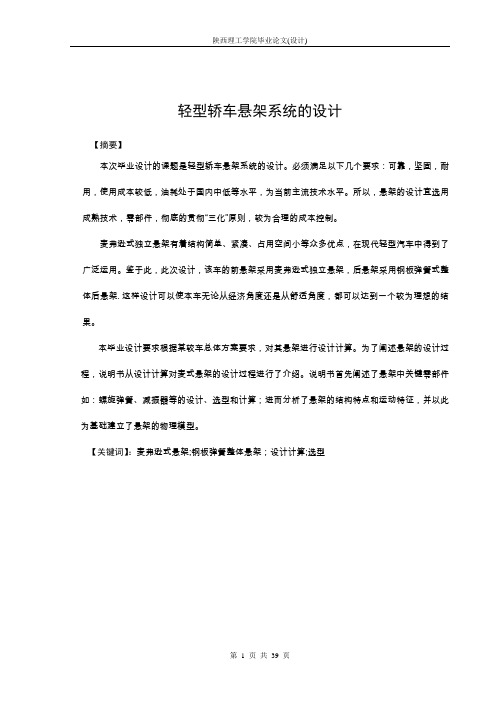
轻型轿车悬架系统的设计【摘要】本次毕业设计的课题是轻型轿车悬架系统的设计。
必须满足以下几个要求:可靠,坚固,耐用,使用成本较低,油耗处于国内中低等水平,为当前主流技术水平。
所以,悬架的设计宜选用成熟技术,零部件,彻底的贯彻“三化”原则,较为合理的成本控制。
麦弗逊式独立悬架有着结构简单、紧凑、占用空间小等众多优点,在现代轻型汽车中得到了广泛运用。
鉴于此,此次设计,该车的前悬架采用麦弗逊式独立悬架,后悬架采用钢板弹簧式整体后悬架.这样设计可以使本车无论从经济角度还是从舒适角度,都可以达到一个较为理想的结果。
本毕业设计要求根据某较车总体方案要求,对其悬架进行设计计算。
为了阐述悬架的设计过程,说明书从设计计算对麦式悬架的设计过程进行了介绍。
说明书首先阐述了悬架中关键零部件如:螺旋弹簧、减振器等的设计、选型和计算;进而分析了悬架的结构特点和运动特征,并以此为基础建立了悬架的物理模型。
【关键词】:麦弗逊式悬架;钢板弹簧整体悬架;设计计算;选型The design of Light passenger vehicle Suspension SystemChen xiang(grade06,class01, Heat Energy and Dynamical Engineering,Shaanxi University of Technology,Hanzhong723000,Shaanxi ,Tutor:shi shao ning)AbstractTime of graduation practice problem is that the light saloon hangs to put up systematic design. As a result, Must satisfy several the following call for: Reliable , sturdy and durable, use cost comparatively low, the low grade is horizontal in oil being consumed being in in the homeland , the technology is horizontal for current main current. The design putting up therefore, hanging ought to select and use the mature technology , component and part , put "three into effect completely spending " principle , comparatively rational cost controls.Maifuxun style has had structure simple , compact independent dangerous rack , has occupied space waiting for a lot of merit for a short time , in modern light automobile to apply broadly. Because of this , this time, going forward designing that , that vehicle hangs to adopt the dyadic independent dangerous Maifuxun rack , rear overhang puts up adopt the dyadic overall of band spring rear overhang rack. Such designs that the angle still is from comfortable angle from economy being able to make this vehicle regardless of , can reach a comparatively ideal result.Graduation practice requires that comparatively, the vehicle overall plan demands , the design being in progress to whose dangerous rack secretly schemes against according to some. For the design setting forth the dangerous rack, process , specifications introduce that from designing that the process calculating the design to dyadic dangerous wheat rack has been in progress. Specifications has set forth dangerous rack middle key component and part first such as: Spiral spring , the design that the shock absorber waits for, choose a type and secretly scheme against; Have analysed the dangerous rack structure characteristic and the physics model moving a characteristic, and being that the basis has built the dangerous rack on this account then.Key words: McPherson suspension;The whole steel spring suspension; design and selection;目录中文摘要 (1)ABSTRACT (2)第一章绪论 (6)1.悬架的功用 (6)2.悬架系统的组成 (7)3.悬架的类型及其特点 (8)3.1非独立悬架的类型及特点 (9)3.2独立悬架的类型及特点 (10)4悬架形式的选择 (13)4.1总评 (13)4.2前后悬架的确定 (14)第二章悬架的设计计算 (14)1.悬架设计要求 (15)2.前悬架的设计计算 (16)2.1弹簧形式的选择 (16)2.2材料的选择 (16)3.弹簧参数的计算 (17)3.1圆柱螺旋弹簧直径d的计算 (17)3.2求有效圈数 (17)3.3其它参数 (18)4.弹簧的校验 (19)5.后悬架的设计计算 (20)5.1弹性元件的选择 (20)5.1.1加工要求 (20)5.2.2材料的参数 (20)6.钢板弹簧参数的设计计算 (21)6.1挠度的确定 (21)6.2各片长度的确定 (22)6.3断面高度及片数的确定 (22)6.4厚度的确定 (23)6.5板簧总成在自由状态下得弧高及其曲率半径 (23)7.钢板弹簧的强度校验 (24)第三章减振器的结构原理及其功用 (25)1.减震器的作用 (26)2.减震器的结构 (27)3.减震器的工作原理 (27)第四章横向稳定器的作用 (28)第五章麦佛逊式悬架导向机构 (30)1独立悬架导向机构 (38)2麦弗逊式悬架系统物理模型的建立 (40)结论 (42)参考文献 (42)致谢 (43)引言此次毕业设计的课题是轻型轿车的悬架系统。
轻型货车悬架系统的设计-任务书

学生姓名
系部
汽车与交通工程学院
专业、班级
指导教师姓名
职称
讲师
从事
专业
车辆工程
是否外聘
□是■否
题目名称
轻型货车悬架系统的设计
一、设计(论文)目的、意义
轻型货车在我国应用较广,其中悬架是轻型货车的的主要部件,其设计的成功与否决定着车辆的行驶平顺性和操纵稳定性、舒适性等多方面的设计要求。设计出结构简单、工作可靠、造价低廉的悬架系统,能大大降低整车生产的总成本,推动汽车经济的发展。所以本题设计一款结构优良的轻型货车悬架系统具有一定的实际意义。
二、设计(论文)内容、技术要求(研究方法)
(一)设计内容
确定悬架总体结构,弹性元件设计,导向机构设计,减振器结构设计,主要参数的确定,对主要参数进行强度校核,验证设计的合理性。
(二)研究方法
1、参考相关资料,对比各种悬架优缺点,初步确定设计方案。
2、实地考察相关类型的车,为最终设计方案提供依据。
3、利用Autocad软件建立轻型货车悬架二维图纸。
[2]工程中的有限元方法(第3版).机械工业出版社,2004
[3]黄天泽,黄金陵.汽车车身结构与设计.机械工业出版社,2000
[4]孙桓主编.机械设计.机械工业出版社出版
[5]余志生. 汽车理论[M],机械工业出版社,1987
[6]陈家瑞主编.汽车构造.人民交通出版社出版
[7]吴镇著.理论力学.上海:上海交通大学出版社,1997
[8]吕慧瑛.机械设计基础.北京:清华大学出版社,2002
六、备注
指导教师签字:
年 月 日
教研室主任签字:
年 月 日
(6)书写设计说明书第11~13周(5月16日~5月29日)(7)设计审核、修改设计说明书第14~16周(5月31日~6月19日)(8)毕业设计答辩准备及答辩 第17周(6月20日~6月26日)
CA1091轻型货车的前后悬架系统设计_毕业设计设计说明书
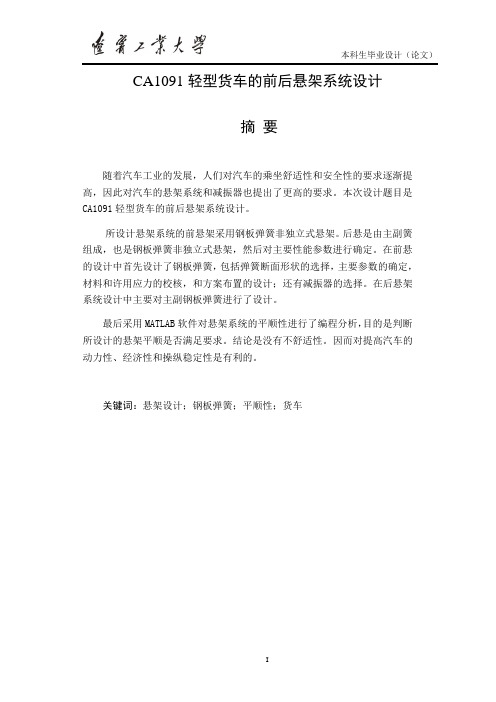
CA1091轻型货车的前后悬架系统设计摘要随着汽车工业的发展,人们对汽车的乘坐舒适性和安全性的要求逐渐提高,因此对汽车的悬架系统和减振器也提出了更高的要求。
本次设计题目是CA1091轻型货车的前后悬架系统设计。
所设计悬架系统的前悬架采用钢板弹簧非独立式悬架。
后悬是由主副簧组成,也是钢板弹簧非独立式悬架,然后对主要性能参数进行确定。
在前悬的设计中首先设计了钢板弹簧,包括弹簧断面形状的选择,主要参数的确定,材料和许用应力的校核,和方案布置的设计;还有减振器的选择。
在后悬架系统设计中主要对主副钢板弹簧进行了设计。
最后采用MATLAB软件对悬架系统的平顺性进行了编程分析,目的是判断所设计的悬架平顺是否满足要求。
结论是没有不舒适性。
因而对提高汽车的动力性、经济性和操纵稳定性是有利的。
关键词:悬架设计;钢板弹簧;平顺性;货车AbstractWith the development of the Automobile industry, people have been promoting the requirement for the safety and ride comfort quality of the vehicle. As a result, there is a higher demand on the suspension and the shock absorber system of the vehicle. The title of this thesis is the design of front and rear suspension systems of CA1046 truck.The front suspension system is the leaf spring, dependent suspension. The rear suspension system consists of the main spring and the helper spring and it is also the leaf spring, dependent suspension. In the procedure of the design we made certain the structural style of the suspension system in the first, then we made certain the main parameters. In the design of the front suspension we designed the leaf spring firstly, including the selection of section shape of leaf spring, made certain the main parameters, material and allowable stress and the design of scheme , moreover the design of shock absorber. In the design of rear suspension we carried out the design of the main spring and the helper spring.In the final design stage, the MATLAB software is used to analyze the ride comfort of the suspension system by programming. The aim is whether suspension ride quality meets to the performance requirement. The results indicate that there is no uncomfortableness for the car on road. Therefore, it is helpful for the dynamical, economical and handling performances of the vehicle.Key words: Suspension Design; Leaf spring; Ride Performance; Truck目录第1章绪论 (1)第2章悬架系统的结构与分析 (3)2.1 悬架的功能和组成 (3)2.2 汽车悬架的分类 (3)2.3 悬架的设计要求 (4)2.4 悬架主要参数 (4)2.4.1 悬架的静挠度fc (4)2.4.2 悬架的动挠度f d (5)2.4.3 悬架弹性特性 (5)2.4.4 后悬架主、副簧刚度的分配 (6)2.4.5 悬架侧倾角刚度及其在前、后轴的分配 (6)第3章前后悬架系统的设计 (7)3.1前悬架系统设计 (7)3.1.1钢板弹簧的设计 (7)3.1.2.减振器的选用 (12)3.2后悬架系统设计 (13)3.2.1悬架主要参数的确定 ................................... 错误!未定义书签。
第十九章汽车车架悬架.pdf
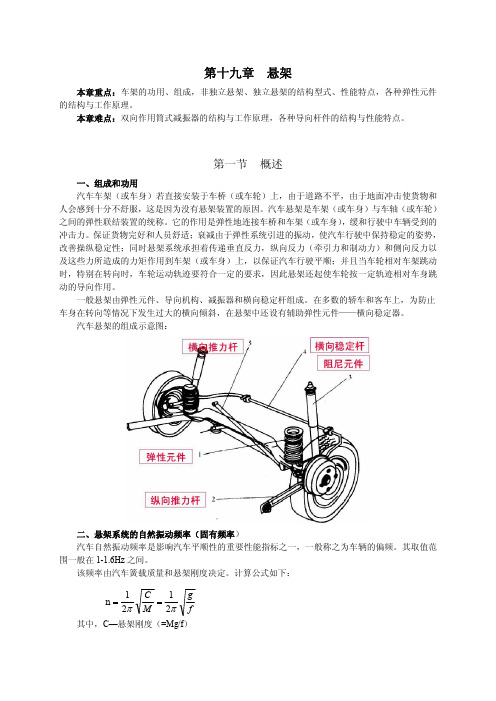
第十九章 悬架本章重点:车架的功用、组成,非独立悬架、独立悬架的结构型式、性能特点,各种弹性元件 的结构与工作原理。
本章难点:双向作用筒式减振器的结构与工作原理,各种导向杆件的结构与性能特点。
第一节 概述一、组成和功用汽车车架(或车身)若直接安装于车桥(或车轮)上,由于道路不平,由于地面冲击使货物和 人会感到十分不舒服,这是因为没有悬架装置的原因。
汽车悬架是车架(或车身)与车轴(或车轮) 之间的弹性联结装置的统称。
它的作用是弹性地连接车桥和车架(或车身),缓和行驶中车辆受到的 冲击力。
保证货物完好和人员舒适;衰减由于弹性系统引进的振动,使汽车行驶中保持稳定的姿势, 改善操纵稳定性;同时悬架系统承担着传递垂直反力,纵向反力(牵引力和制动力)和侧向反力以 及这些力所造成的力矩作用到车架(或车身)上,以保证汽车行驶平顺;并且当车轮相对车架跳动 时,特别在转向时,车轮运动轨迹要符合一定的要求,因此悬架还起使车轮按一定轨迹相对车身跳 动的导向作用。
一般悬架由弹性元件、导向机构、减振器和横向稳定杆组成。
在多数的轿车和客车上,为防止 车身在转向等情况下发生过大的横向倾斜,在悬架中还设有辅助弹性元件——横向稳定器。
汽车悬架的组成示意图:二、悬架系统的自然振动频率(固有频率)汽车自然振动频率是影响汽车平顺性的重要性能指标之一,一般称之为车辆的偏频。
其取值范 围一般在 11.6Hz 之间。
该频率由汽车簧载质量和悬架刚度决定。
计算公式如下:其中,C—悬架刚度(=Mg/f )fg M C p p 2 1 2 1 n = =M—簧载质量f—挠度由以上公式可知:簧载质量一定,悬架刚度越小,偏频越小,但悬架垂直变形增大。
悬架刚度一定,簧载质量越大,偏频越小。
为使车辆的载荷变化时 n 的变化小,需要悬架的弹簧具有变刚度特性,以保证车辆在不同的载 荷情况下具有相当的行驶平顺性。
三、 悬架系统的类型按汽车悬架的性能是否可控,分为:被动悬架:悬架刚度、阻尼在行驶中不可调整的悬架。
轻型货车悬架系统的设计
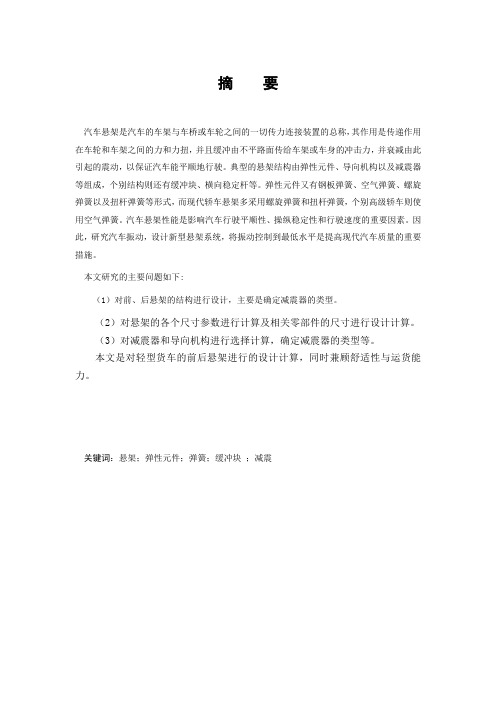
摘要汽车悬架是汽车的车架与车桥或车轮之间的一切传力连接装置的总称,其作用是传递作用在车轮和车架之间的力和力扭,并且缓冲由不平路面传给车架或车身的冲击力,并衰减由此引起的震动,以保证汽车能平顺地行驶。
典型的悬架结构由弹性元件、导向机构以及减震器等组成,个别结构则还有缓冲块、横向稳定杆等。
弹性元件又有钢板弹簧、空气弹簧、螺旋弹簧以及扭杆弹簧等形式,而现代轿车悬架多采用螺旋弹簧和扭杆弹簧,个别高级轿车则使用空气弹簧。
汽车悬架性能是影响汽车行驶平顺性、操纵稳定性和行驶速度的重要因素。
因此,研究汽车振动,设计新型悬架系统,将振动控制到最低水平是提高现代汽车质量的重要措施。
本文研究的主要问题如下:(1)对前、后悬架的结构进行设计,主要是确定减震器的类型。
(2)对悬架的各个尺寸参数进行计算及相关零部件的尺寸进行设计计算。
(3)对减震器和导向机构进行选择计算,确定减震器的类型等。
本文是对轻型货车的前后悬架进行的设计计算,同时兼顾舒适性与运货能力。
关键词:悬架;弹性元件;弹簧;缓冲块;减震ABSTRACTAutomotive vehicle suspension frame and axle or the wheel of all transmission between the general term for connecting devices, and its role is to transfer the role at the wheel and frame and between the torsional force, and uneven pavement from the buffer Biography to the frame or body of the impact, and the attenuation caused by vibration, to ensure the vehicle can travel smoothly. A typical structure of a flexible suspension components, shock absorbers and other agencies, as well as orientation of the individual block structure is also a buffer, such as horizontal Stabilizer. Elastic components and leaf springs, air springs, coil spring, as well as the form of torsion bar spring, and the use of many modern cars suspension coil spring and torsion bar springs, individual car use advanced air springs. Suspension performance is the impact of motor vehicles to motor cars and ride comfort, handling and stability and an important factor in speed. Therefore, the research vehicle vibration, the design of the new suspension system to the minimum level of vibration control is to improve the quality of Hyundai Motor important measures.The main problems discussed in this paper are as follows:(1)Front and rear suspension design of the structure, primarily determine the type of shock absorber.(2)The various dimensions of the suspension parameters were calculated and related parts of the size of the design calculations(3)The guiding mechanism of shock absorber selection calculations to determine the types of shock absorbers.This article is for light goods vehicles, front and rear suspension design and calculation, taking into account the comfort and cargo capacity.Key words:Suspension;Elastic element;Spring;Block buff;Damping目录摘要 (I)Abstract (II)第1章绪论 (1)1.1 汽车悬架概述 (1)1.2我国汽车悬架发展的现状 (2)1.3 研究的背景及意义 (3)1.4 毕业论文研究内容 (4)第2章悬架的结构形式分析及选择 (5)2.1 非独立悬架和独立悬架 (5)2.2 前、后悬架方案的选择 (6)2.3 辅助元件 (6)2.4 本章总结 (7)第3章主要参数的选择 (8)3.1 选择的要求及方法 (8)3.2 悬架的静绕度 (8)3.3 悬架动挠度 (9)3.4 悬架弹性特性 (9)3.5 本章总结 (10)第4章弹性元件的计算 (11)4.1 钢板弹簧的布置方案的选择 (11)4.2 钢板弹簧主要参数的确定 (11)4.2.1 满载弧高 (11)4.2.2钢板弹簧长度L的确定 (12)4.3 钢板弹簧总成在自由状态下的弧高及曲率半径计算 (15)4.4 钢板弹簧的刚度验算 (17)4.5 弹簧的最大应力点及最大应力 (18)4.6 弹簧卷耳和弹簧销的强度核算 (19)4.7螺旋弹簧的设计计算 (21)4.7.1螺旋弹簧形式、材料的选择 (21)4.7.2确定弹簧直径及刚度 (21)4.7.3 其他参数的计算 (22)4.7.4弹簧的校验 (22)4.8 本章总结 (23)第5章减振器的设计计算 (24)5.1 减振器的分类 (24)5. 2 主要性能参数的选择 (24)5.2.1 相对阻尼系数ψ (24)5.2.2 减振器阻尼系数的确定 (25)5.2.3 最大卸荷力的确定 (26)5.3 筒式减振器主要尺寸参数的确定 (26)5.4 本章总结 (27)第6章导向机构的设计 (28)6.1导向机构的布置参数 (28)6.2 麦弗逊式悬架导向机构设计 (29)6.3本章总结 (32)结论 (33)参考文献 (34)致谢 (35)附录 (36)第1章绪论1.1汽车悬架概述悬架由弹性元件、导向装置、减振器、缓冲块和横向稳定器等组成。
悬架系统设计说明书
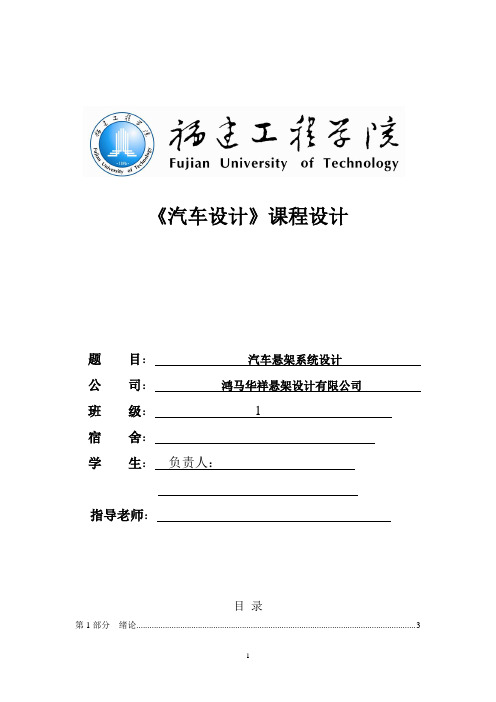
《汽车设计》课程设计题目:汽车悬架系统设计公司:鸿马华祥悬架设计有限公司班级: 1宿舍:学生:负责人:指导老师:目录第1部分绪论 (3)1.1 悬架系统的功能 (3)1.2悬架的工作原理 (3)1.3 悬架系统的分类 (5)1.4 设计任务 (11)第2部分悬架主要参数的确定 (11)2.1 悬架的静挠度fc的确定 (11)2.2 悬架的动挠度fd的选择 (13)2.3 悬架的弹性特性 (13)2.4 后悬架主副弹簧刚度的分配 (14)2.5 悬架侧倾角刚度及在前、后轴的分配 (15)2.6悬架的空间几何参数 (16)第3部分弹性元件的设计 (17)3.1 弹性元件简介 (17)3.2 螺旋弹簧的设计 (18)3.2.1 螺旋弹簧的刚度 (18)3.2.2 计算弹簧钢丝直径d (19)3.2.3 弹簧校核 (19)3.3 小结 (20)第4部分悬架导向机构的设计 (20)4.1 导向机构受力分析 (23)4.2 横臂轴线布置方式的选择 (24)4.3 横摆臂主要参数 (25)第5部分减振器的设计 (26)5.1减震器简介 (26)5.2 双筒式液力减振器 (27)5.3 单筒充气式液力减振器 (30)5.4 减震器参数的设计 (32)第6部分横向稳定杆的设计 (36)6.1 横向稳定杆的作用 (36)6 .2 横向稳定杆参数的选择 (36)第7部分悬架的CATIA 3D建模图 (37)7.1前悬架系统——麦弗逊式独立悬架 (37)7.2 后悬架系统——双横臂式独立悬架 (38)第8部分参考文献 (39)第9部分会议记录 (40)9.1 会议记录1 (40)9.2 会议记录2 (41)9.3 会议记录3 (41)第10部分任务报表..................................................................................... 错误!未定义书签。
轻型货车(双排座)后悬架的设计

汽车设计课程设计说明书轻型货车(双排座)后悬架的设计学院:机械与车辆工程学院专业(班级):车辆工程专业作者(学号):XXX(XXX)指导教师:XXX(XXX)完成日期:201X年XX月XX日蚌埠学院教务处制目录1 引言 (1)2 设计的主要要求 (3)2.1 悬架的主要性能 (3)2.2 已知悬架参数 (3)3 悬架各部分的参数 (5)3.1 悬架的静挠度fc (5)3.2 悬架的动挠度fd (5)3.3 悬架的弹性特性 (6)4 弹性元件的设计 (7)4.1 钢板弹簧的布置方案选择 (7)4.2 钢板弹簧的主要参数的确定 (7)4.2.1 满载弧高fa (7)4.2.2 钢板弹簧长度L的确定 (7)4.2.3 钢板弹簧断面尺寸的确定 (7)4.2.4 钢板弹簧各片尺寸的确定 (9)4.3 弹簧刚度的验算 (10)4.4 钢板弹簧总成在自由状态下的弧高及曲率半径计算 (11)4.5 钢板弹簧总成弧高的核算 (13)5 钢板弹簧强度验算 (14)6 钢板弹簧主片的强度的核算 (15)7 钢板弹簧弹簧销的强度的核算 (16)8 致谢 (17)参考文献 (18)轻型货车(双排座)后悬架的设计1 引言目前悬架系统主要有空气悬架、橡胶悬架和钢板弹簧悬架三种类型,本课程设计采用是主、副簧形式的板簧悬架,因而会侧重于介绍板簧悬架基本构造及研究现状。
钢板弹簧悬架又分为少片变截面钢板悬架与等截面多片板簧悬架。
目前国内95%以上的重卡悬架系统是以钢板弹簧为弹性元件兼作导向装置的非独立悬架,其主要优点是结构简单,制造容易,维修方便,工艺成熟,工作可靠。
缺点是汽车平顺性、舒适性较差;簧下质量大,无法适应车辆轻量化的发展,并且不能同时兼顾车辆的舒适性与操纵稳定性。
钢板弹簧是汽车悬架中应用最广泛的一种弹性元件,它是由若干片等宽但不等长(厚度可以相等,也可以不相等)的合金弹簧片组合而成的一根近似等强度的弹性梁,多数情况下由多片弹簧组成。
- 1、下载文档前请自行甄别文档内容的完整性,平台不提供额外的编辑、内容补充、找答案等附加服务。
- 2、"仅部分预览"的文档,不可在线预览部分如存在完整性等问题,可反馈申请退款(可完整预览的文档不适用该条件!)。
- 3、如文档侵犯您的权益,请联系客服反馈,我们会尽快为您处理(人工客服工作时间:9:00-18:30)。
CA1091轻型货车的前后悬架系统设计随着汽车工业的发展,人们对汽车的乘坐舒适性和安全性的要求逐渐提 高,因此对汽车的悬架系统和减振器也提出了更高的要求。
本次设计题目是 CA1091轻型货车的前后悬架系统设计。
组成,也是钢板弹簧非独立式悬架,然后对主要性能参数进行确定。
在前悬 的设计中首先设计了钢板弹簧,包括弹簧断面形状的选择,主要参数的确定, 材料和许用应力的校核,和方案布置的设计;还有减振器的选择。
在后悬架 系统设计中主要对主副钢板弹簧进行了设计。
最后采用MATLAB 软件对悬架系统的平顺性进行了编程分析,目的是 判断所设计的悬架平顺是否满足要求。
结论是没有不舒适性。
因而对提高汽 车的动力性、经济性和操纵稳定性是有利的关键词:悬架设计;钢板弹簧;平顺性;货车AbstractWith the developme nt of the Automobile in dustry, people have bee n promoting the requireme nt for the safety and ride comfort quality of the vehicle. As a result, there is a higher dema nd on the suspe nsion and the shock absorber system of the 所设计悬架系统的前悬架采用钢板弹簧非独立式悬架。
L 冃日 后悬疋由主副簧vehicle. The title of this thesis is the desig n of front and rear suspe nsion systems of CA1046 truck.The front suspe nsion system is the leaf spri ng, depe ndent suspe nsion. The rear suspe nsion system con sists of the main spri ng and the helper spri ng and it is also the leaf spri ng, depe ndent suspe nsion. In the procedure of the design we made certain the structural style of the suspe nsion system in the first, the n we made certa in the main parameters. In the desig n of the front suspe nsion we desig ned the leaf spri ng firstly, in cludi ng the selecti on of sect ion shape of leaf spri ng, made certa in the main parameters, material and allowable stress and the desig n of scheme , moreover the desig n of shock absorber. I n the desig n of rear suspe nsion we carried out the desig n of the main spri ng and the helper spri ng.In the final desig n stage, the MATLAB software is used to an alyze the ride comfort of the suspension system by programming. The aim is whether suspe nsion ride quality meets to the performa nee requireme nt. The results indicate that there is no uncomfortableness for the car on road. Therefore, it is helpful for the dyn amical, econo mical and han dli ng performa nces of the vehicle.Key words: Suspension Design; Leaf spring; Ride Performanee;Truck第1章绪论 (1)第2章悬架系统的结构与分析 (3)2.1悬架的功能和组成 (3)2.2汽车悬架的分类 (3)2.3悬架的设计要求 (4)2.4悬架主要参数 (4)2.4.1 悬架的静挠度fc (4)2.4.2悬架的动挠度fd (5)2.4.3悬架弹性特性 (5)2.4.4后悬架主、副簧刚度的分配 (6)2.4.5悬架侧倾角刚度及其在前、后轴的分配 (6)第3 章前后悬架系统的设计 (7)3.1前悬架系统设计 (7)3.1.1钢板弹簧的设计 (7)3.1.2.减振器的选用 (12)3.2后悬架系统设计 (13)3.2.1悬架主要参数的确定..................... 错误!未定义书签。
3.2.2弹性元件的设计......................... 错误!未定义书签。
3.2.3钢板弹簧强度验算 (24)3.2.4钢板弹簧主片的强度核算 (25)3.2.4钢板弹簧弹簧销的强度核算 (25)第4章平顺性分析和编程 (26)4.1平顺性的定义 (26)4.2平顺性的研究 (26)4.3平顺性的研究分析 (27)第5章结论 (33)参考文献 (34)致谢 (35)附录I:夕卜文资料 (36)附录U: 中文翻译 (42)附录IH: 程序 (42)第一章绪论悬架是汽车的车架与车桥或车轮之间的一切传力连接装置的总称,汽车车架(或车身)若直接安装于车桥(或车轮)上,由于道路不平,地面冲击使货物和人会感到十分不舒服,这是因为没有悬架装置的原因。
它的作用是弹性地连接车桥和车架(或车身),缓和行驶中车辆受到的冲击力。
保证货物完好和人员舒适;衰减由于弹性系统引进的振动,使汽车行驶中保持稳定的姿势,改善操纵稳定性;同时悬架系统承担着传递垂直反力,纵向反力(牵引力和制动力)和侧向反力以及这些力所造成的力矩作用到车架(或车身)上,以保证汽车行驶平顺;并且当车轮相对车架跳动时,特别在转向时,车轮运动轨迹要符合一定的要求,因此悬架还起使车轮按一定轨迹相对车身跳动的导向作用。
悬架是汽车中的一个重要总成,它把车架与车轮弹性地联系起来,关系到汽车的多种使用性能。
一般悬架由弹性元件、导向机构、减振器和横向稳定杆组成。
弹性元件用来承受并传递垂直载荷,缓和由于路面不平引起的对车身的冲击。
弹性元件种类包括钢板弹簧、螺旋弹簧、扭杆弹簧、油气弹簧、空气弹簧和橡胶弹簧。
减振器用来衰减由于弹性系统引起的振,减振器的类型有筒式减振器,阻力可调式新式减振器,充气式减振器。
导向机构用来传递车轮与车身间的力和力矩,同时保持车轮按一定运动轨迹相对车身跳动,通常导向机构由控制摆臂式杆件组成。
种类有单杆式或多连杆式的。
钢板弹簧作为弹性元件时,可不另设导向机构,它本身兼起导向作用。
有些轿车和客车上,为防止车身在转向等情况下发生过大的横向倾斜,在悬架系统中加设横向稳定杆,目的是提高横向刚度,使汽车具有不足转向特性,改善汽车的操纵稳定性和行驶平顺性。
现在悬架发展十分快,不断出现崭新的悬架装置。
按控制形式不同分为从动式悬架和主动式悬架。
现代汽车中的悬架有两种,一种是从动悬架,另一种是主动悬架。
从动悬架即传统式的悬架,是由弹簧、减振器(减振筒)、导向机构等组成,它的功能是减弱路面传给车身的冲击力,衰减由冲击力而引起的承载系统的振动。
其中弹簧主要起减缓冲击力的作用,减振器的主要作用是衰减振动。
由于这种悬架是由外力驱动而起作用的,所以称为从动悬架。
而主动悬架的控制环节中安装了能够产生抽动的装置,采用一种以力抑力的方式来抑制路面对车身的冲击力及车身的倾斜力。
由于这种悬架能够自行产生作用力,因此称为主动悬架。
现代汽车对平顺性和操纵稳定性和舒适性的要求越来越高,已成为衡量汽车性能好坏的标准。
悬架结构形式和性能参数的选择合理与否,直接对汽车行驶平顺性、操纵稳定性和舒适性有很大的影响。
由此可见悬架系统在现代汽车上是重要的总成之一。
汽车的固有频率是衡量汽车平顺性的重要参数,它由悬架刚度和悬架弹簧支承的质量(簧载质量)所决定。
人体所习惯的垂直振动频率约为1〜1.6Hz。
车身振动的固有频率应接近或处于人体适应的频率范围,才能满足舒适性要求。
在悬架垂直载荷一定时,悬架刚度越小,固有频率就越低,但悬架刚度越小,载荷一定时悬架垂直变形就越大。
这样若无有足够大的限位行程,就会使撞击限位块的概率增加。
若固有频率选取过低,很可能会出现制动点头角,转弯侧货角,空载和满载车身高度变化过大。
一般货车固有频率是 1.5〜2Hz,旅行客车1.2〜1.8Hz,高级轿车1〜1.3Hz。
另外,当悬架刚度一定时,簧载质量越大,悬架垂直变形也愈大,而固有频率越低。
空车时的固有频率要比满载时的高。
簧载质量变化范围大,固有频率变化范围也大。
为了使空载和满载固有频率保持一定或很小变化,需要把悬架刚度做成可变或可调的。
影响汽车平顺性的另一个悬架指标是簧载质量。
簧载质量分为簧上质量与簧下质量两部分,由弹性元件承载的部分质量,如车身、车架及其它所有弹簧以上的部件和载荷属于簧上质量。
车轮、非独立悬架的车轴等属于簧下质量,也叫非簧载质量M。
如果减小非簧载质量可使车身振动频率降低,而车轮振动频率升高,这对减少共振,改善汽车的平顺性是有利的。
非簧载质量对平顺性的影响,常用非簧载质量和簧载质量之比m/M进行评价。
影响汽车平顺性的另一重要指标是阻尼比,此值取大,能使振动迅速衰减,但会把路面较大的冲击传递到车身,值取小,振动衰减慢,受冲击后振动持续时间长,使乘客感到不舒服。
为充分发挥弹簧在压缩行程中作用,常把压缩行程的阻尼比设计得比伸张小。
悬架的侧倾角刚度及前后匹配是影响汽车操纵稳定性的重要参数。
当汽车受侧向力作用发生车身侧倾,若侧倾角过大,乘客会感到不安全,不舒适,如侧倾角过小,车身受到横向冲击较大,乘客也会感到不适,司机路感不好。
所以,整车侧倾角刚度应满足:当车身受到0.4g侧向加速度时,其侧倾角在2.5〜4。
范围内,汽车有一定不足转向特性,前悬架侧倾角刚度应大于后悬架侧倾角刚度。
一般前悬架侧倾角刚度与后悬架侧倾角刚度比应在 1.4〜2.6范围内,如前后悬架本身不能满足上述要求,可在前后悬架中加装横向稳定杆,提高汽车操纵稳定性。
